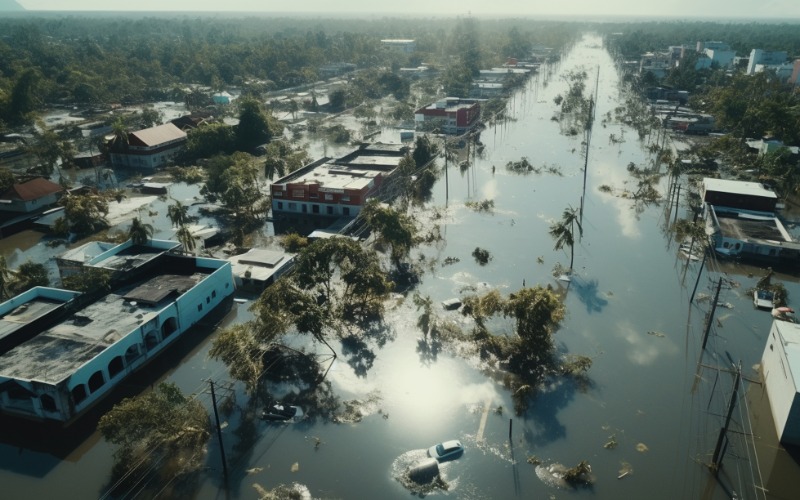As climate change progresses, one thing is clear — flooding is on the rise. With heavier rainfall, higher sea levels, and storm surges becoming more common, our cities and infrastructure need serious upgrades.
But don’t picture dull, gray levees and concrete barriers — today’s flood control infrastructure is smarter, greener, and way cooler. Cities worldwide are reinventing the way they tackle flooding, blending cutting-edge tech with nature-inspired solutions that are as savvy as they are stylish.
So, what does flood control look like in the 21st century? Think sponge cities, floating buildings, and underground reservoirs — all working together to keep our cities dry and our spirits high.
1. Sponge Cities: Soaking up the Solution
Imagine a city designed to absorb water like a sponge. No, this isn’t a concept from a sci-fi novel — it’s happening right now in places like Wuhan, China. The sponge city concept revolves around green infrastructure that mimics natural hydrological processes. Think permeable pavements, green rooftops, and rain gardens that capture and filter rainwater.
These systems can hold excess water during heavy rains and then slowly release it back into the ground or even into a recycling system for irrigation. This kind of flood control infrastructure is great for urban areas that often get hit hard by flash floods. Aside from minimizing flood risk, this system helps improve air quality and green up urban areas.
The best part? Sponge cities do their work quietly, with minimal disruption to residents. They are a shining example of how sustainable infrastructure can address multiple urban issues simultaneously, making them a perfect fit for modern cities with flooding challenges.
2. Smart Drainage Systems: Say Goodbye to Clogged Drains
If you’ve ever walked down a street ankle-deep in water, you’ll appreciate smart drainage systems. Just as effective as launched horizontal drains that relieve ground water pressure and strengthen slopes, these smart systems use sensors and IoT technology to monitor water levels in real-time. When heavy rains hit, they can automatically open and close valves to divert water away from vulnerable areas.
For instance, Cincinnati in the United States already uses smart drainage networks that react to changing weather conditions. With machine learning algorithms, these systems can even predict flooding before it happens.
This gives cities a chance to take preventive measures, keeping streets clear and businesses open and reducing the impact of floods. And, let’s be honest, there’s something wonderfully futuristic about a drain that can think for itself.
3. Floating Buildings: Taking “Rising Above It” to a New Level
What if, instead of avoiding water, we embraced it? Floating buildings do just that, providing a flood-resilient option in areas where water levels are prone to change. From floating houses to an entire floating community in the Netherlands, these structures aren’t just ideas — they’re real, functional spaces where people live, work, and play.
These buildings rise and fall with the water, so they’re virtually immune to flooding. Some are tethered to flexible poles, while others float freely within designated areas. Beyond being practical, floating buildings are also incredibly eco-friendly. Many incorporate solar panels, water recycling systems, and other green technologies, making them a sustainable choice for future coastal developments.
Floating buildings offer a stylish and sustainable way to coexist with rising water levels, making them a wise investment for flood-prone areas.
4. Underground Reservoirs: Out of Sight, Out of Flood Risk
When it comes to urban flood control infrastructure, space is at a premium. That’s why underground reservoirs are an increasingly popular option. These massive tanks lie beneath city streets, ready to capture millions of gallons of rainwater during a storm. Once the rain stops, the water can be gradually released back into rivers or treated and reused.
Tokyo has taken this approach to a new level with the G-Cans Project, an enormous underground reservoir capable of draining 7,000 cubic feet of water per second. It’s an engineering marvel, complete with towering pillars and a network of tunnels, and it plays a crucial role in keeping Tokyo dry.
The beauty of underground reservoirs is that they don’t interfere with urban life above ground — all that flood control magic happens quietly beneath our feet. By storing excess rainwater underground, cities can reduce the risk of surface flooding without sacrificing valuable urban space.
5. Living Shorelines: A Natural Approach to Flood Control
Rising sea levels and unpredictable weather patterns cause an increase in flood frequency, which can be incredibly daunting for coastal cities. Enter living shorelines — flood control infrastructure that combines natural elements like oyster reefs, wetlands, and mangroves to form a protective barrier against the ocean’s fury. Unlike traditional seawalls, which can deteriorate over time, living shorelines actually get stronger as they grow.
In addition to reducing flood risk, living shorelines also create habitats for wildlife, improve water quality, and help sequester carbon. This win-win solution is gaining popularity in places like Louisiana and North Carolina. Living shorelines are a great reminder that sometimes, the best way to protect our cities is to let nature lend a hand.
Living shorelines — which blend human ingenuity with natural resilience — offer a powerful and sustainable way to protect coastal areas from flooding.
The Future of Flood Control Infrastructure: Think Big, Think Bold
As climate change continues to challenge our cities, we must think big, boldly, and outside the box. Flood control infrastructure will need to evolve, not just to keep up with rising water levels but to stay ahead of them. And with each new innovation, we get a little closer to a world where floods are less about destruction and more about adaptation.
Whether it’s the absorbent charm of a sponge city or the eco-friendly appeal of living shorelines, flood control infrastructure is an essential part of our climate-resilient future. The next time a storm rolls in, remember that we can’t stop the rain, but we can certainly manage it with style, smarts, and just a hint of wit.










